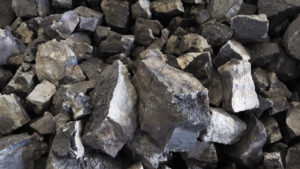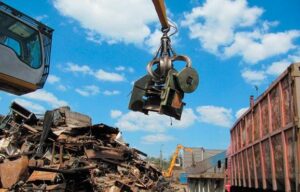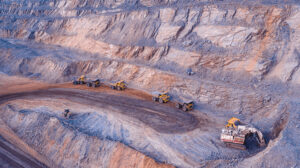
In January-October of this year, Ukraine increased its ferroalloy exports by 31.9% in physical terms compared to the same period last year, to 87,379 tons.
According to statistics released by the State Customs Service (SCS) on Wednesday, in monetary terms, ferroalloy exports increased by 25.5% to $98.064 million.
The main exports were to Poland (27.09% of shipments in monetary terms), Algeria (23.09%), and Turkey (21.52%).
In addition, Ukraine imported 32,255 thousand tons of this product in the first 10 months of 2025, a decrease of 58.4% compared to the same period in 2024. In monetary terms, imports fell by 53.5% to $61.045 million. Imports were mainly from Norway (19.49%), Kazakhstan (16.29%), and France (9.87%).
As reported, the Pokrovsky Mining and Processing Plant (PGZK, formerly Ordzhonikidze Mining and Processing Plant) and the Marganetsky Mining and Processing Plant (MGZK, both in Dnipropetrovsk region), which are part of the Privat Group, stopped mining and processing raw manganese ore in late October-early November 2023, while NZF and ZZF stopped smelting ferroalloys. In the summer of 2024, ferroalloy plants resumed production at a minimum level.
PGZK and MGZK did not produce any products in 2024, while in 2023, PGZK produced 160.31 thousand tons of manganese concentrate, and MGZK was idle.
In 2024, Ukraine reduced its exports of ferroalloys in physical terms by 4.45 times compared to 2023, to 77,316 thousand tons from 344,173 thousand tons. and in monetary terms, it decreased by 3.4 times, to $88.631 million from $297.595 million. At the same time, the main exports were to Poland (27.40% of supplies in monetary terms), Turkey (21.53%), and Italy (19.82%).
In addition, Ukraine imported 82,259 tons of this product last year, compared to 14,203 tons in 2023 (a 5.8-fold increase). In monetary terms, imports increased 3.3 times, from $42.927 million to $140.752 million. Imports were mainly from Poland (32.71%), Norway (19.55%), and Kazakhstan (13.9%).
The business of ZZF, NZF, Stakhanov ZF (located at NKT), Pokrovsky and Marganetsky GZK was organized by PrivatBank prior to the nationalization of the financial institution. The Nikopol Ferroalloy Plant is controlled by the EastOne group, created in the fall of 2007 as a result of the restructuring of the Interpipe group, as well as the Privat group.

In January-October 2025, Ukrainian companies increased exports of ferrous metal scrap by 52.1% compared to the same period last year — to 345,197 tons from 226,970 tons.
According to statistics released by the State Customs Service (SCS) on Wednesday, 33,357 tons were exported in October, 28,785 tons in September, 34,713 tons in August, 44,842 thousand tons in July, a record 47,691 thousand tons in June, 28.6 thousand tons in May, 46,321 thousand tons in April, 39,908 thousand tons in March, in February – 25,284 thousand tons, in January – 15,696 thousand tons of scrap.
In monetary terms, scrap exports in January-October increased by 43.4% – to $103.052 million from $71.862 million.
During this period, scrap exports were formally carried out mainly to Poland (81.08% of shipments in monetary terms), Greece (6.19%), and Italy (5.47%).
In the first 10 months of this year, Ukraine imported 34 tons of scrap worth $13,000 from Poland (53.85%), the Seychelles (30.77%), and the British Virgin Islands (7.69%).
As reported, due to the sharp increase in exports of strategic raw materials from Ukraine, the Ministry of Economy initiated the introduction of a licensing and quota regime for scrap exports with a zero quota. A public discussion of the draft resolution is currently underway. Its implementation is expected to contribute to the smooth operation of Ukraine’s metallurgical and foundry industries, as well as to stabilize the situation with regard to meeting the demand for scrap on the domestic market of Ukraine.
In 2024, Ukraine’s scrap collection companies increased their exports of ferrous metal scrap by 60.7% compared to 2023, from 182,465 thousand tons to 293,190 thousand tons. In monetary terms, scrap exports for the year increased by 73.2% to $91.311 million from $52.723 million.

In January-October of this year, Ukrainian mining companies reduced exports of iron ore raw materials (IORM) in physical terms by 4.41% compared to the same period last year, from 27 million 790.352 thousand tons to 26 million 565.296 thousand tons.
According to statistics released by the State Customs Service (SCS) on Wednesday, foreign currency proceeds from iron ore exports decreased by 14.3% during this period, from $2 billion 341.865 million to $2 billion 7.246 million.
Exports of raw materials were mainly to China (44.49% of shipments in monetary terms), Slovakia (16.97%), and Poland (16.78%).
In addition, in January-October 2025, Ukraine imported mineral resources worth $86,000 in the amount of 118 tons from the Netherlands (51.16%), Italy (33.72%), and Norway (15.12%), while in the same period last year it imported 835 tons worth $261,000.
As reported, in 2024, Ukraine increased its exports of raw materials by 89.8% compared to 2023, to 33 million 699.722 thousand tons, and foreign exchange earnings grew by 58.7%, to $2 billion 803.223 million UAH.
In 2024, Ukraine imported mineral resources worth $414,000 in a total volume of 2,042 tons, while in 2023, 250 tons of these raw materials were imported worth $135,000. In 2023, exports of raw materials decreased by 26% in real terms compared to 2022, to 17 million 753,165 thousand tons. Foreign exchange earnings amounted to $1 billion 766,906 million (a decrease of 39.3%). A total of 250 tons of raw materials were imported for $135,000.

According to an analytical report by Relocation, the average price of secondary housing in Spain reached a historic high of €2,555 per square meter in October 2025, which is 15.7% more in annual terms and 1.5% more than in September. In some markets, the growth was even higher: in the province of Malaga, the average price of secondary housing rose to €3,842 per square meter in August, +13.8% year-on-year. The INE’s nationwide housing price index for the second quarter recorded +12.7% year-on-year, with secondary housing rising by 12.8%.
Prices in Spain are being driven by a shortage of supply, high demand in coastal provinces and on the islands, and sustained activity from foreign buyers. According to Relocation, up to 80% of potential buyers face the problem of affordability and a lack of suitable properties, which further pushes prices up.
The leaders in terms of regional dynamics are the Costa del Sol, the Balearic and Canary Islands, and the provinces of Alicante and Valencia. In the large agglomerations of Madrid and Barcelona, demand is sustained by the rental market and limited construction.
Spanish business publications forecast further growth of 4-6% for 2025-2026, with a shortage of new supply on the market.

Romanian law enforcement agencies have detained former senator Marius Ovidiu Isele on suspicion of attempting to bribe Defense Minister Ionut Mosatan with €1 million to facilitate an ammunition deal. According to investigators, the scheme involved purchasing Soviet-style shells in Kazakhstan, importing them, and “rebranding” them in Romania, then selling them through an intermediary in Bulgaria for delivery to Ukraine. This was reported by Radio Liberty, citing investigation materials and participants in the events.
The head of the state-owned company Romtehnica, Razvan Minku, said that he had been approached with a proposal to use his contacts in Kazakhstan to resell ammunition, but he considered the proposal suspicious and refused. The intermediary was politician Octavian Bercian, who contacted law enforcement agencies and made 17 hidden recordings of meetings with Isele. The court imposed a preventive measure on the former senator in the form of 30 days of pre-trial detention.
There are also reports about Bulgarian businessman Roman Ivanov Angelov, the sole owner of Sofia Arm Tech, which received a license for international arms trade in 2024. His whereabouts are unknown, and he has not responded to journalists’ inquiries. The defense minister stated on social media that he had refused any meetings and that the attempt to “buy his influence” had been rejected.
The publication notes that the initiators hoped to attract funds from the European Rearm Europe program to support the defense industry of EU countries in the future, but the scheme remained at the trial stage and was not implemented.
Rearm Europe was launched by the European Commission in March 2025 to stimulate arms production in EU countries. Romtehnica is the authorized intermediary of the Romanian Ministry of Defense for international procurement and sales of arms and military equipment.